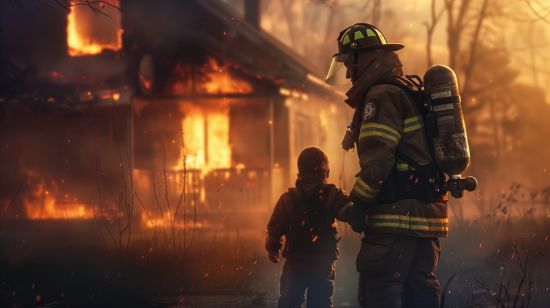We have become accustomed to our petrochemical dependency. We wear petroleum. We sit on petroleum. Our cars are made from many petroleum-based parts. They burn petroleum distillates for fuel. We use plastic everywhere and for almost everything. So why do we wonder when a spark causes a fire that burns our house down?
Homes Today Are Toxic Plastic Fire Traps
The British Columbia Wildfire Service has published a guide for homeowners. It was created because the Canadian province, like California, has endured increasingly long fire seasons. Wildland-urban fires are more frequent today than ever before because municipalities are encroaching on wildlands.
The BC recommendations talk about removing combustible materials from around the perimeter of homes establishing a fire break of 1.5 metres (5 feet) that is free of both non-vegetation and vegetation combustibles. It doesn’t talk about what is in the house or even about the car and the clothes you wear.
In the most recent Los Angeles area wildfire-urban conflagrations, over 12,000 structures including thousands of homes have burned to the ground. One key reason for the destruction can be found in materials used within and around the buildings.
Our combustibility is not limited to where and in what we live. I did an inventory of what I was wearing two days ago. I had on underwear and a sweatshirt with tags that warned me not to get too close to a flame.
That’s right!
Why? Because my clothes were made from petroleum and other synthetics. I concluded I was as likely to go up in smoke as some of the furnishings in my apartment if a fire were to erupt.
You see, today, modern homes are toxic plastic firetraps. Plastic and synthetics ignite faster and burn hotter than natural materials like wood, cotton and wool. Most plastics ignite between 300 and 500 Celsius (572 to 932 Fahrenheit). Synthetic materials like nylon ignite at temperatures slightly higher than plastic.
The smoke that plastic and synthetics produce contains toxic chemicals. For example, when PVC pipe used for plumbing in modern homes instead of copper ignites at around 420 Celsius, it releases a combination of hydrogen chloride (an irritant), carbon monoxide (an asphyxiant), chlorine-based gasses (poisonous), benzene, formaldehyde and many other dangerous chemicals.
Studies show that homes containing lots of these combustible materials are susceptible to flashover fires that burn six times faster than homes made and furnished using traditional natural materials.
Zoning Is A House Killer In The Face of Wildfires
Another reason why our homes are susceptible to burning to the ground is municipal zoning. Zoning rules for buildings contribute to firestorms like the ones Los Angeles has seen in its higher-density neighbourhoods in the last month.
Proximity facilitates rapid fire spread. When one structure catches fire, nearby ones overheat. The radiant heat from one causes combustible materials in the next house to ignite. No spark or ember is needed. Plastics and synthetics have without a spark or ember. Vegetation planted around the house that is not fire-resistant becomes a combustion source.
Wildland-Urban Interfaces Are Dangerous Places
The intrusion of homes into wild areas called wildland-urban interfaces (WUIs) makes them more susceptible to wildfires particularly when you add all that plastic and petroleum-based ignitables.
The WUI in both Canada and the United continues to grow.
A U.S. Department of Agriculture Forest Service 2018 report stated the WUI grew 41% between 1990 and 2010 with the number of new houses from 30.8 to 43.4 million and 33% in land area from 581,000 to 770,000 square kilometres. Within the perimeter of wildfires that broke out in the U.S. between 1990 and 2015, there were 286,000 houses in 2010 versus 177,000 in 1990. These numbers continue to rise making even more houses susceptible to WUI wildfires.
In Canada, the 2016 wildfire that enveloped Fort McMurray, a city that largely is located in a WUI, destroyed nearly 1,600 structures and forced the evacuation of 80,000 residents. In 2021, the town of Lytton, BC, burned down within minutes a wildfire swept through it. The 2023 wildfire season was described as the most destructive the country had ever seen with fires burning out smaller urban centres located within WUIs. The town of Jasper, a picturesque tourist destination, witnessed a wildfire in 2024 that destroyed much of it. Jasper is located in the middle of a national park which is the definition of a WUI.
The National Research Council of Canada has published a guide for WUI fires and through an infrastructure initiative has developed climate-resilient building guidelines. When I saw guidelines for building homes in a WUI zone I was taken aback. Nevertheless, these guidelines provide building standards and a code for construction within proximity to a WUI. What’s included are exterior and foundation walls, roofing materials, doors, windows, decks, balconies and exterior additions. What the guidelines don’t tell you is what to do on the inside. The life safety tips section of the guidelines doesn’t talk about couches covered in synthetic materials, deck chairs and backyard decks made from plastic-looking wood materials.
Paying Attention To Where You Live And The Stuff You Own
We need to pay attention to wildfires more than ever as the planet sees atmospheric median temperatures continue to rise. Climate change in the 21st century has its own rules. Climate extremes like droughts that cause wildfires to proliferate are becoming the norm.
The people of Los Angeles have been through a hellish experience. Even then they will rebuild just as are the people in Fort McMurray, Lytton and Jasper. Will they be more aware of the stuff they have and their surroundings and the contribution each has made to their losses?
The lives lost are a tragedy. The stuff lost can be replaced but please, if you don’t have to, don’t build near or within a WUI and make the effort to end your petroleum addiction or you and your house could go up in smoke once again.








